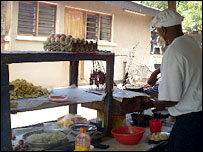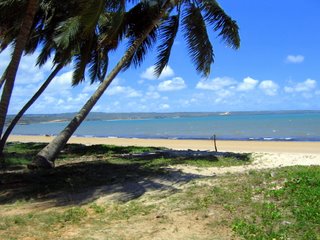Usually, when I have been offered a Tanzanian breakfast, it consists of a couple of chapati (basically a deep-fried, thick tortilla) and chai (tea). At their worst, chapati can be flavorless, tough gut-busters, but I admit there have been a few times when a nice hot chapati really hits the spot. Granted, that spot is frequently the thighs and rear, so I try to go light on the chapati. The accompanying chai might be plain or spiced with masala, a blend of cinnamon, cloves, and cardamom… yum! Many Tanzanians also eat dense, heavy doughnut-like creations such as maandazi (large and made from wheat) or vitumbua (smaller, made from rice flour). I admit I haven’t tried them yet…

Lunch is normally the biggest meal of the day. Lunch and dinner are similar, and people’s favorite dishes usually depend on the region where they are from. People from coastal towns are more likely to choose rice, while people from inland areas are more likely to favor ugali, which guidebooks and dictionaries like to translate as polenta, but I take issue with that association. Ugali is a kind of doughy, bland, glutinous, springy concoction resembling gluey mashed potatoes crossed with Play-Doh made of maize, cassava, millet, wheat, or sorghum flour. No seasonings are usually added. I think you can tell where I stand on ugali (pictured below).

Along with ugali or rice is served a sauce (sausi), usually tomato-based, often with some sort of meat cooked in it. The sauces are usually delicious. As I am partial to beef, I had a nasty surprise this lunchtime with a mystery meat that turned out to be chicken liver. Side dishes are usually chopped and stewed greens (mchicha), and red beans stewed with onions and spices (maharage). I really love the red beans over rice, maybe because it’s not that far removed from New Orleans-style food. The saving grace for this spicy food lover is pilipili, a kind of semi-cooked hot-pepper salsa. Pilipili are red and green peppers that closely resemble jalapenos or Scotch bonnets in flavor, and are chopped up and cooked with tomatoes and onions. People here think it’s hysterical that an mzungu asks for pilipili. My mother-in-law would love it!
Street food is cheap, very filling, and Tums-worthy. On offer are usually mishkaki (beef kebabs), kuku (chicken), mayai (eggs), or occasionally kitimoto (pork). All are usually accompanied by chipsi (french fries), and occasionally a fresh (or not-so-fresh, depending on how long it has been sitting) tomato and onion salad. The food is commonly precooked and then re-heated in a pan over a grill with a hefty ladling of oil. On the coast, you can occasionally find fried pweza (octopus) on the menu -- be forewarned that it has been tenderized by beating it with a rock on the sandy beach! Below is a picture of a typical food stall (like the one I ate at in Lindi).

In northwest Tanzania, plantains and green bananas (ndizi) are a staple of people’s diets, and people will often eat plantains with meat in a sauce (ndizi nyama), as in the picture below. Sometimes I enjoy the plantains, especially if the sausi is flavorful, but sometimes they’re a bit chewy and strange. Along the coast, the Swahili influence has infused Indian spices into some of the dishes, so biriyani and pilau are common rice dishes served in coastal towns, with or without meat. I love both of them, though I have to be careful to avoid chomping down on a big piece of cinnamon bark or a whole cardamom pod in my lunch! My favorite meal by far, however, is njegere (peas), which is green shelled peas and other vegetables cooked in a coconut curry and served over rice.

I admit I have been spoiled food-wise by starting out in Dar, where there are tons of Indian restaurants, Chinese restaurants, Ethiopian food, burger joints, French pastry shops, etc. According to the Rough Guide published this past summer, in Mtwara where I will be living once my research project starts, there are only 4 restaurants that serve non-Tanzanian fare, and 3 of these serve only Indian food. And I thought cheese was a precious commodity in Dar…



